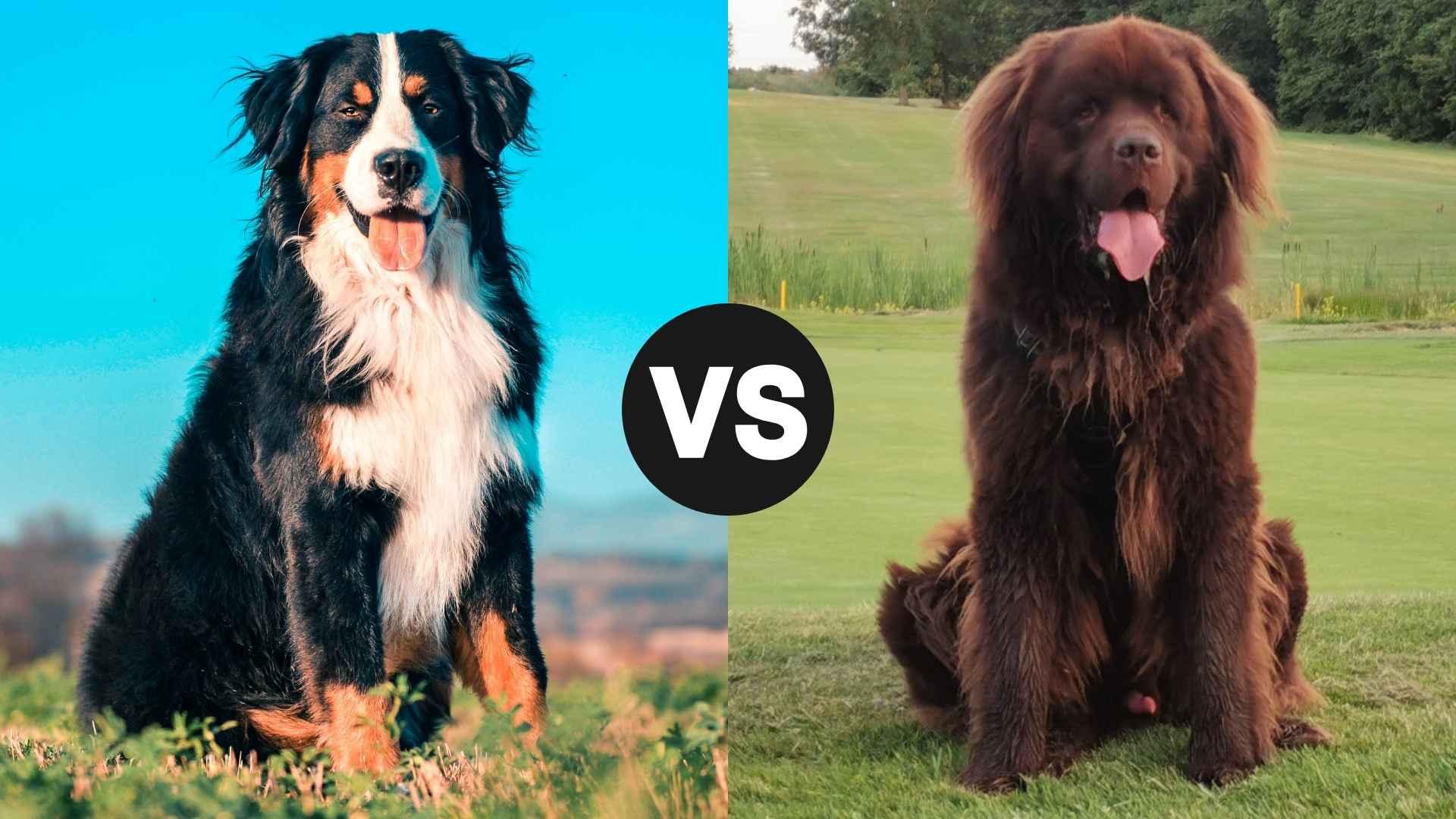Picture a massive, fluffy dog bounding through snow-covered hills or lounging peacefully by the fire with kids snuggled up beside it. Sounds like a dream?
Then you’re already halfway to falling in love with the Bernese Mountain Dog and the Newfoundland. These two gentle giants are not just strikingly beautiful, but they’re also famously devoted and incredibly affectionate.
But which of these lovable furballs is right for you? The Bernese Mountain Dog, with its tricolor coat and cheerful energy, is a Swiss farm dog that adores its family. Meanwhile, the Newfoundland is a sweet-tempered water lover with a heart as big as its body—think lifeguard meets teddy bear.
Both breeds are ideal for families, but their differences in grooming needs, exercise needs, temperament, and lifespan are worth exploring before you commit to a new excellent companion. We’ll dive into the details that separate these two snow-loving snuggle machines to help you make an informed—and heartwarming—choice.
If you’re ready for a life filled with drool, fur, and unconditional love, this comparison is your perfect starting point.
Bernese Mountain Dog vs. Newfoundland
Size and Height Comparison
Let’s just say… You won’t be tucking either of these guys into your handbag unless your handbag is a small hatchback.
Bernese Mountain Dog
These Swiss beauties are big, no doubt, but they’re more of the “tall and fluffy athlete” type. Males typically weigh 80–115 lbs and stand 25–28 inches tall at the shoulder. Females are slightly smaller, but still impressively sized. They’re strong, agile, and built like they’re always ready to haul firewood or befriend every child in the village.
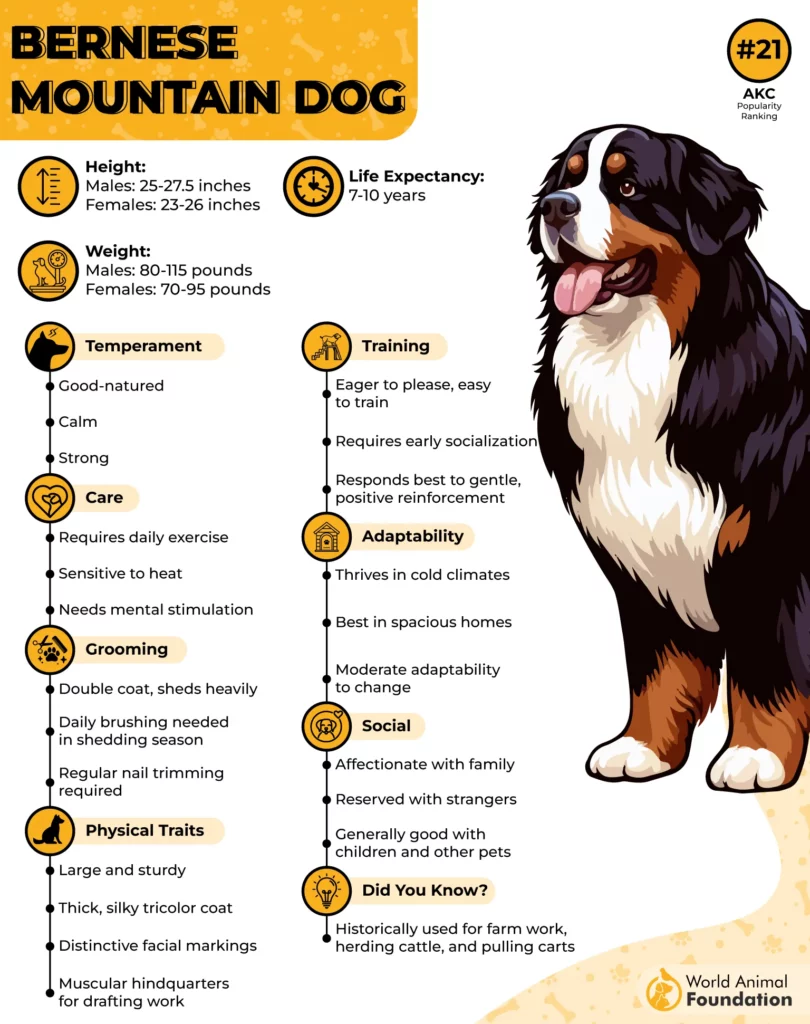
Newfoundland
Meet the heavyweight champion of the canine cuddle contest. According to the AKC, these majestic giants rank among the largest dog breeds in the world, and owning a pet that might outweigh you brings some clear challenges.
Newfoundlands are massive—males can weigh in at 130–150 lbs (some even hit the 180 lb mark!), and Newfoundlands average height is around 27–29 inches tall. Females usually clock in at a slightly lighter weight, but let’s be real: these dogs are living, breathing bean bag chairs.
Coat Type and Texture
Spoiler alert: Both breeds rock a coat that makes you want to run your fingers through their fur while whispering, “Who’s a good fluffy boy?” But the differences are in the details.
Bernese Mountain Dog
Think silky waves and elegant fluff. The Berner’s coat is long, straight, or slightly wavy and has that beautiful tri-color pattern—black with rust and white markings that make them look like they’re always dressed in formal Swiss attire. Their fur is double-coated (meaning heavy shedding twice a year), but it’s a bit lighter and less oily than the Newfie’s.
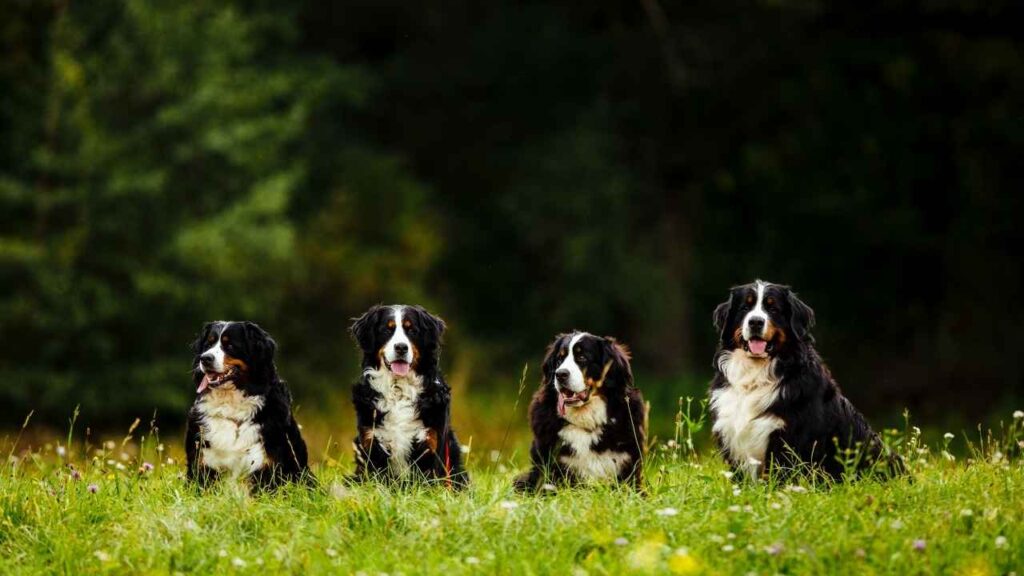
Newfoundland
If the Bernese is wearing a luxurious tux, the Newfoundland is in a full-on waterproof parka. Their thick, coarse, and water-resistant double coat is made for icy swims and dramatic ocean rescues. The texture is dense and woolly, often described as having a “greasy” feel to repel water, which means after a swim, they’ll dry off somewhere… and that place will never be the same again.
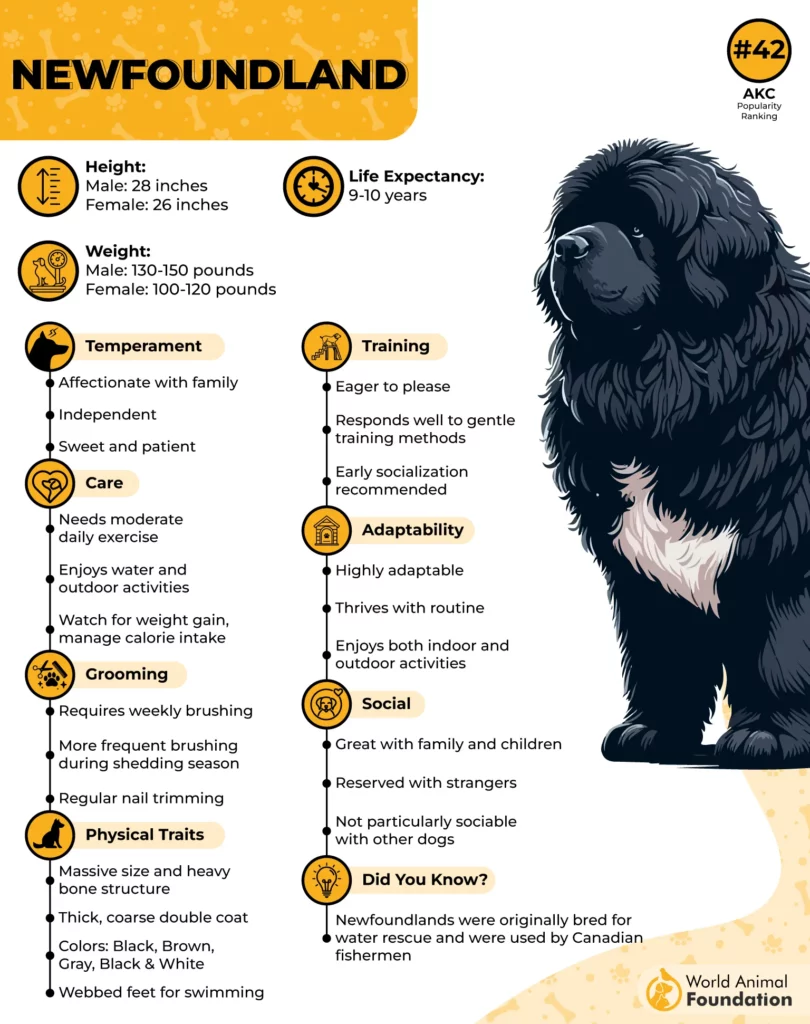
Temperament and Personality
Both breeds deliver in spades when it comes to big dog energy—and we mean the wholesome, marshmallow-hearted, carry-your-slippers kind.
Bernese Mountain Dog
The Bernese is that friend who helps you move house, brings snacks, and tells you you’re doing great, even when you’re not. These dogs are known for being:
✅ Affectionate and loyal: Total Velcro dogs. They’ll follow you from room to room, even if you’re just going to get your phone charger.
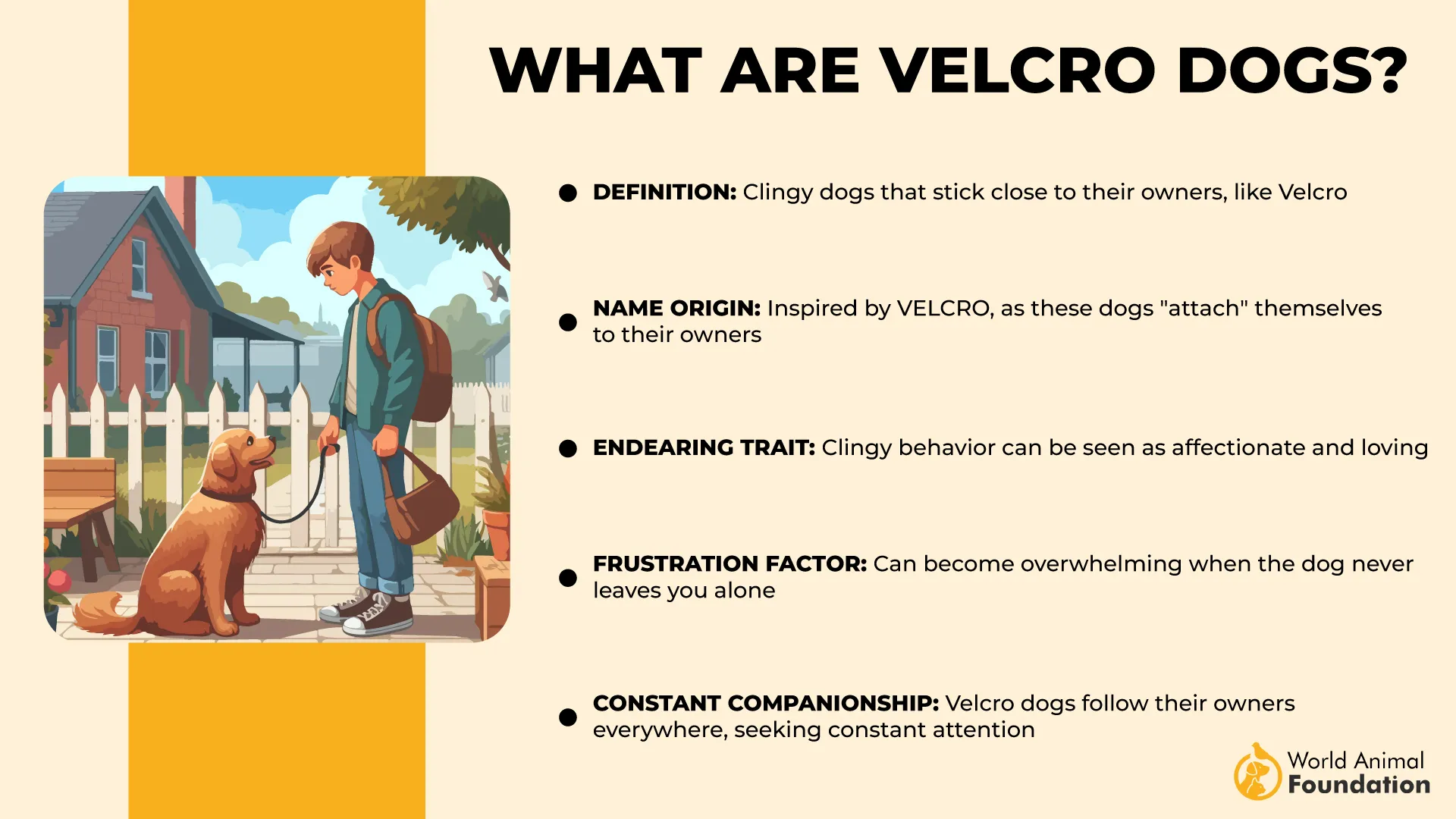
✅ They are gentle nature, often earning the nickname “nanny dogs” for their excellent behavior around children.
✅ Slightly shy: Berners can be a bit reserved with strangers, like a dog who prefers a quiet dinner over a wild party.
✅ Sensitive souls: Yell near a Berner and prepare for the “Why are you mad at me? I just want to love you” eyes.
Newfoundland
If the Bernese is the helpful friend, the Newfoundland is the big-hearted lifeguard who offers you a warm towel, emotional support, and a giant, furry shoulder to cry on. Traits include:

✅ Extremely gentle and patient: They’re often called “nanny dogs” because of how naturally nurturing they are, especially with children, says WebMD.
✅ Incredibly sweet-natured: Even their bark sounds like it’s asking politely.
✅ Calm and easygoing: Newfies are known for their “zen” attitude. They’d rather meditate with you than play fetch for hours.
✅ Social butterflies: They’re more likely to greet strangers with a slobbery kiss than suspicion.
Energy Levels
Let’s just say neither of these dogs is about to become a triathlete, but they do have some differences in their daily “zoomies” quota.
Bernese Mountain Dog
These dogs are like weekend warriors: energetic outdoors, calm indoors.
Moderate energy: PetMD notes they require moderate exercise to maintain their health and well-being. They love a good hike, some farm work, or a romp in the snow, but they’re also happy to sprawl out afterward.
Playful and alert: This large breed will chase a ball, patrol the yard, or happily accompany you on a nature walk.
Not marathon runners: These water dogs are athletic, but not built for endless activity.
Newfoundland
Let’s be honest—Newfies are more into slow and steady than fast and furious.
Low to moderate energy: They’re happiest plodding along on a walk or supervising your gardening like a furry foreman.
Loves swimming: Seriously, put a Newfoundland near water and watch the magic happen.
Professional nappers: Don’t be surprised if they conk out halfway through your Netflix show… and snore like a chainsaw.
If you want a more active, agile buddy, the Bernese Mountain Dog is your four-legged soulmate. And if you’re looking for a calm, loving companion who doubles as a cuddle puddle and a lifeguard, the Newfoundland will happily take over your heart—and your couch.
Common Health Issues
These lovable giants aren’t just heart-stealers—they can be heartbreakers, too, when it comes to health. Both breeds have some known medical concerns, and regular checkups, good nutrition, and a dash of “please-don’t-eat-that” can go a long way.
Bernese Mountain Dog
Unfortunately, the Bernese tends to draw the short straw in the canine health lottery. Their stunning looks come with some genetic baggage.
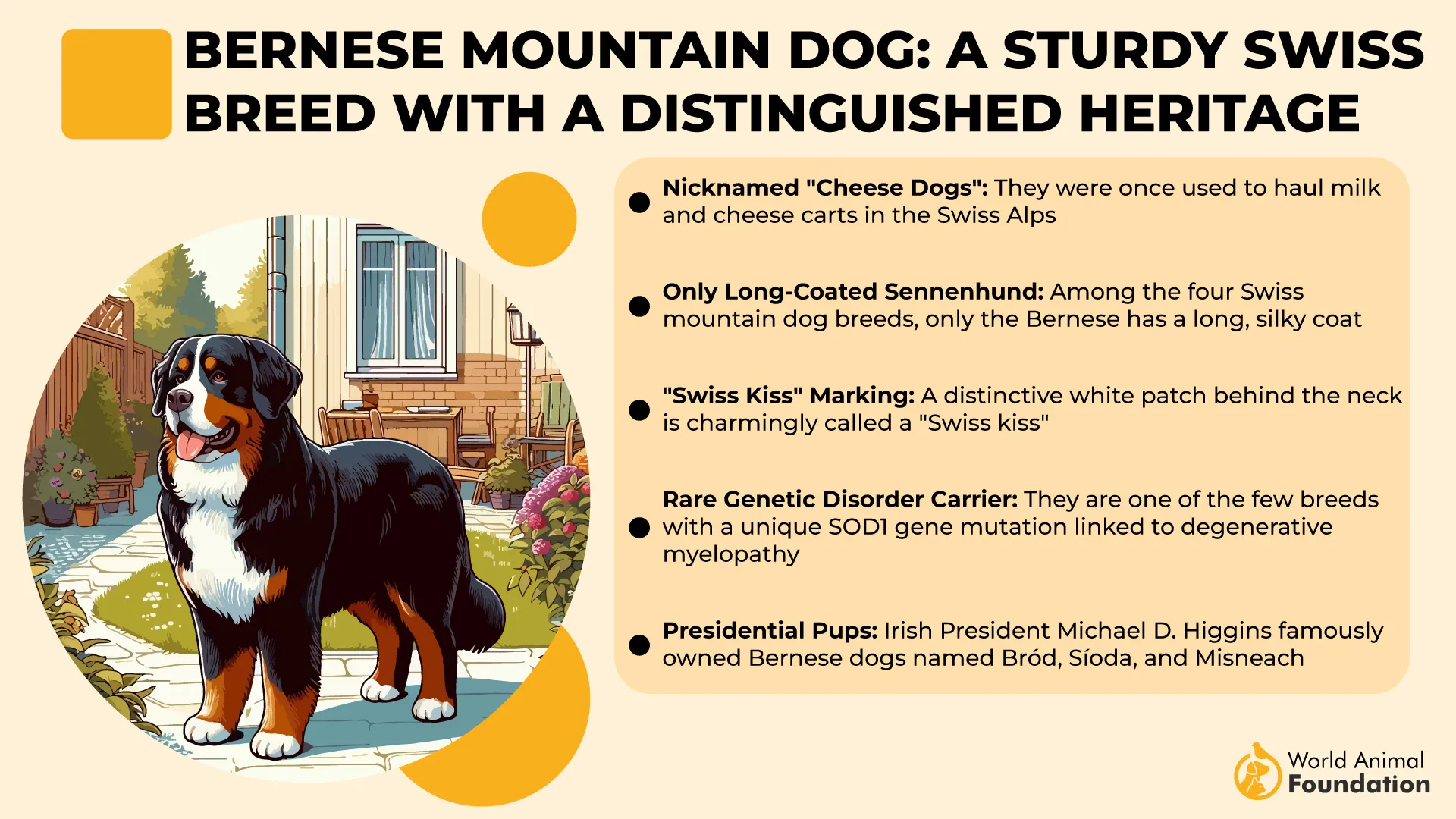
Common issues:
Cancer
Hip and elbow dysplasia
Bloat (gastric torsion)
Progressive retinal atrophy (PRA)
Heart disease
On the bright side? With love, exercise, and a good vet, you can help them live a quality life full of tail wags and belly rubs.
Newfoundland
While also prone to big-dog issues, Newfies tend to fare slightly better in the cancer department—but they’ve got their own quirks.
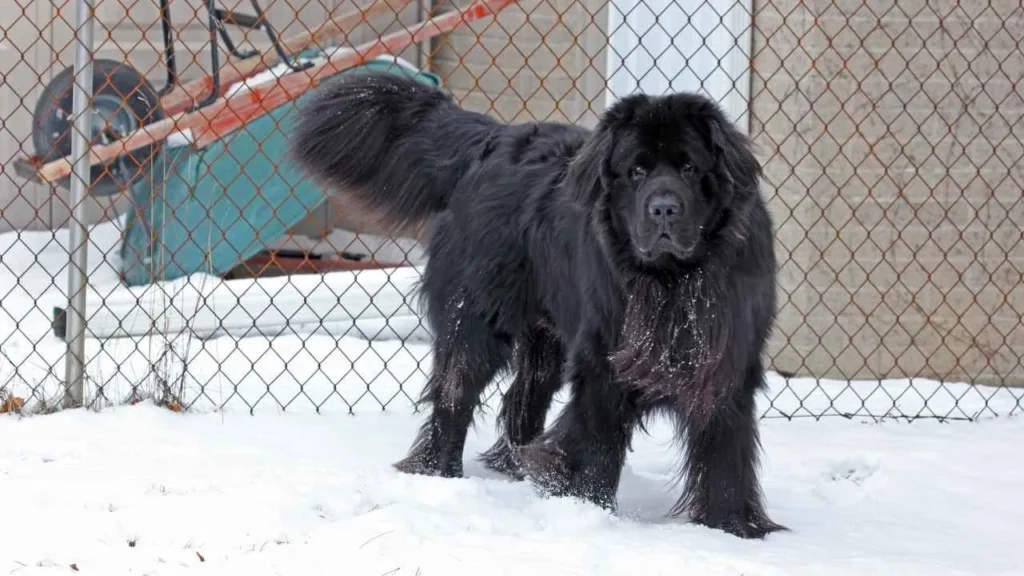
Common issues:
Hip and elbow dysplasia
Subvalvular aortic stenosis (SAS)
Cystinuria
Bloat
Obesity
But both breeds require vigilant care and health screening—your vet might just become part of the family.
Life Expectancy
Here’s the tough part: giant breeds often mean shorter lifespans. But oh, do they pack a lifetime of love into those years.
Bernese Mountain Dog
Average lifespan: 6–8 years
Some may reach 9 or 10, but sadly, many face health challenges early. It’s short, but golden.
Newfoundland
Average lifespan: 8–10 years
With good care and luck, some live to 11 or 12. That’s a lot of slobbery kisses and lazy Sundays.
Overview: Key Differences
|
Feature |
Bernese Mountain Dog |
Newfoundland |
|---|---|---|
|
Size & Weight |
Medium giant — 80–115 lbs; 25–28 inches tall |
Larger giant — 130–150+ lbs; 27–29 inches tall |
|
Coat Type |
Long, silky, tri-color (black, rust, white), slightly wavy |
Thick, dense, water-resistant double coat, usually black, brown, or Landseer (white & black) |
|
Personality |
Incredibly loyal, affectionate, gentle, a little shy with strangers |
Gentle giant, super patient, social, calm & nurturing |
|
Energy Level |
Moderate — enjoys hikes and play, but is happy to relax |
Low to moderate — loves slow walks & swimming, professional napper |
|
Common Health Issues |
Higher risk of cancer, hip/elbow dysplasia, bloat |
Hip/elbow dysplasia, heart defects, cystinuria, bloat |
|
Life Expectancy |
Shorter — 6 to 8 years |
Slightly longer — 8 to 10 years |
|
Drool Factor |
Moderate |
High — prepare the towels! |
|
Best For |
Active families who want a big, playful companion with mountain-dog vibes |
Families wanting a calm, loving giant with a heart as big as their paws |
If you want a sporty, tri-color mountain buddy who’s affectionate but a bit shy, go for the Bernese Mountain Dog. If you want a massive, gentle, water-loving cuddle cloud who’s as calm as a monk, the Newfoundland is your best bud. Both bring the kind of love that fills your home—and your heart—right to the brim.
Conclusion
When comparing the Bernese Mountain Dog vs Newfoundland, both are large breeds initially bred as traditional farm dogs and working companions—Bernese in the Swiss Alps and Newfoundlands by Canadian fishermen. These intelligent dogs are people pleasers and do well with proper training, early socialization, and positive reinforcement, avoiding harsh correction. While both are pet-friendly and get along with other pets and animals, Newfoundlands often have more energy and require more exercise and outdoor activities, while Bernese mountain dogs tend to enjoy long walks and spending time with their owners.
Shedding season brings excessive shedding for both, especially due to their dense undercoat, making regular grooming essential. Bernese are heavy shedders and can be the wrong choice for owners not ready for that. Obedience training should start when the puppy is young, using treats and patience. Choosing between these two breeds depends on lifestyle, personal preferences, and understanding key differences. Reputable breeders can help match the right dog breed to your needs, ensuring your furry friend fits well into your family and home.


